Related Research Articles
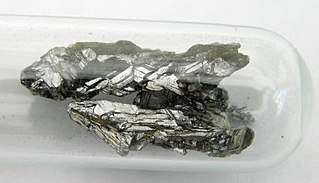
Arsenic is a chemical element with the symbol As and atomic number 33. Arsenic occurs in many minerals, usually in combination with sulfur and metals, but also as a pure elemental crystal. Arsenic is a metalloid. It has various allotropes, but only the gray form, which has a metallic appearance, is important to industry.

Antimony is a chemical element with the symbol Sb (from Latin: stibium) and atomic number 51. A lustrous gray metalloid, it is found in nature mainly as the sulfide mineral stibnite (Sb2S3). Antimony compounds have been known since ancient times and were powdered for use as medicine and cosmetics, often known by the Arabic name kohl. The earliest known description of the metal in the West was written in 1540 by Vannoccio Biringuccio.

A metal is a material that, when freshly prepared, polished, or fractured, shows a lustrous appearance, and conducts electricity and heat relatively well. Metals are typically malleable or ductile. A metal may be a chemical element such as iron; an alloy such as stainless steel; or a molecular compound such as polymeric sulfur nitride.
A metalloid is a type of chemical element which has a preponderance of properties in between, or that are a mixture of, those of metals and nonmetals. There is no standard definition of a metalloid and no complete agreement on which elements are metalloids. Despite the lack of specificity, the term remains in use in the literature of chemistry.
The periodic table is laid out in rows to illustrate recurring (periodic) trends in the chemical behaviour of the elements as their atomic number increases: a new row is begun when chemical behaviour begins to repeat, meaning that elements with similar behaviour fall into the same vertical columns. The fifth period contains 18 elements, beginning with rubidium and ending with xenon. As a rule, period 5 elements fill their 5s shells first, then their 4d, and 5p shells, in that order; however, there are exceptions, such as rhodium.

A pnictogen is any of the chemical elements in group 15 of the periodic table. This group is also known as the nitrogen family. It consists of the elements nitrogen (N), phosphorus (P), arsenic (As), antimony (Sb), bismuth (Bi), and perhaps the chemically uncharacterized synthetic element moscovium (Mc).
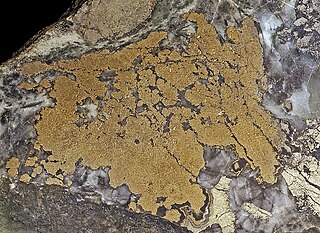
Nickeline or niccolite is a mineral consisting of nickel arsenide (NiAs) containing 43.9% nickel and 56.1% arsenic.

Tennantite is a copper arsenic sulfosalt mineral with an ideal formula Cu12As4S13. Due to variable substitution of the copper by iron and zinc the formula is Cu6[Cu4(Fe,Zn)2]As4S13. It is gray-black, steel-gray, iron-gray or black in color. A closely related mineral, tetrahedrite (Cu12Sb4S13) has antimony substituting for arsenic and the two form a solid solution series. The two have very similar properties and is often difficult to distinguish between tennantite and tetrahedrite. Iron, zinc, and silver substitute up to about 15% for the copper site.
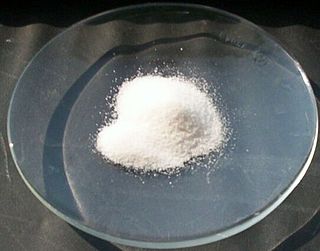
Arsenic trioxide, sold under the brand name Trisenox among others, is an inorganic compound and medication. As an industrial chemical, whose major uses include in the manufacture of wood preservatives, pesticides, and glass. As a medication, it is used to treat a type of cancer known as acute promyelocytic leukemia. For this use it is given by injection into a vein.
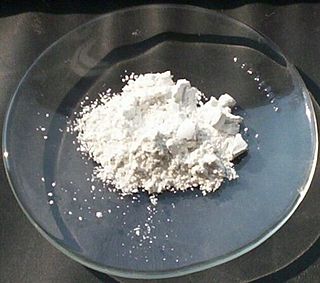
Antimony(III) oxide is the inorganic compound with the formula Sb2O3. It is the most important commercial compound of antimony. It is found in nature as the minerals valentinite and senarmontite. Like most polymeric oxides, Sb2O3 dissolves in aqueous solutions with hydrolysis. A mixed arsenic-antimony oxide occurs in the nature as the very rare mineral stibioclaudetite.
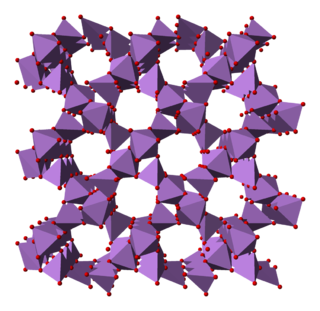
Arsenic pentoxide is the inorganic compound with the formula As2O5. This glassy, white, deliquescent solid is relatively unstable, consistent with the rarity of the As(V) oxidation state. More common, and far more important commercially, is arsenic(III) oxide (As2O3). All inorganic arsenic compounds are highly toxic and thus find only limited commercial applications.

Arsenical bronze is an alloy in which arsenic, as opposed to or in addition to tin or other constituent metals, is added to copper to make bronze. The use of arsenic with copper, either as the secondary constituent or with another component such as tin, results in a stronger final product and better casting behavior.

A native metal is any metal that is found pure in its metallic form in nature. Metals that can be found as native deposits singly or in alloys include aluminium, antimony, arsenic, bismuth, cadmium, chromium, cobalt, indium, iron, manganese, molybdenum, nickel, niobium, rhenium, selenium, tantalum, tellurium, tin, titanium, tungsten, vanadium, and zinc, as well as the gold group and the platinum group. Among the alloys found in native state have been brass, bronze, pewter, German silver, osmiridium, electrum, white gold, silver-mercury amalgam, and gold-mercury amalgam.

Silver mining is the extraction of the precious metal silver from the Earth through excavation.
Speisses are alloys of heavy metals like iron, cobalt, nickel and copper with arsenic, antimony and, occasionally, tin. The latter elements lower the melting point to around 1000 °C. Speisses commonly occur in lead smelting operations and copper smelting operations.

Getchellite is a rare sulfide of arsenic and antimony, AsSbS3, that was discovered by B. G. Weissberg of the New Zealand Department of Scientific and Industrial Research in 1963, and approved as a new species by the International Mineralogical Association in 1965. Many metal sulfides are grey to black, but a few are brightly colored. Orpiment is yellow to brownish gold, cinnabar is deep red and getchellite is a bright orange red.

Native element minerals are those elements that occur in nature in uncombined form with a distinct mineral structure. The elemental class includes metals and intermetallic elements, metalloids, and nonmetals. The Nickel–Strunz classification system also includes the naturally occurring phosphides, silicides, nitrides, carbides, and arsenides.

Stibarsen or allemontite is a natural form of arsenic antimonide (AsSb) or antimony arsenide (SbAs). The name stibarsen is derived from Latin stibium (antimony) and arsenic, whereas allemonite refers to the locality Allemont in France where the mineral was discovered. It is found in veins at Allemont, Isère, France; Valtellina, Italy; and the Comstock Lode, Nevada; and in a lithium pegmatites at Varuträsk, Sweden. Stibarsen is often mixed with pure arsenic or antimony, and the original description in 1941 proposed to use stibarsen for AsSb and allemontite for the mixtures. Since 1982, the International Mineralogical Association considers stibarsen as the correct mineral name.
References
- ↑ "Arsenic Mineral Data". webmineral.com. Retrieved 2021-02-11.
- ↑ "Arsenic: The mineral native Arsenic information and pictures". www.minerals.net. Retrieved 2021-02-11.
- ↑ "Stibarsen". www.mindat.org. Retrieved 2021-02-11.